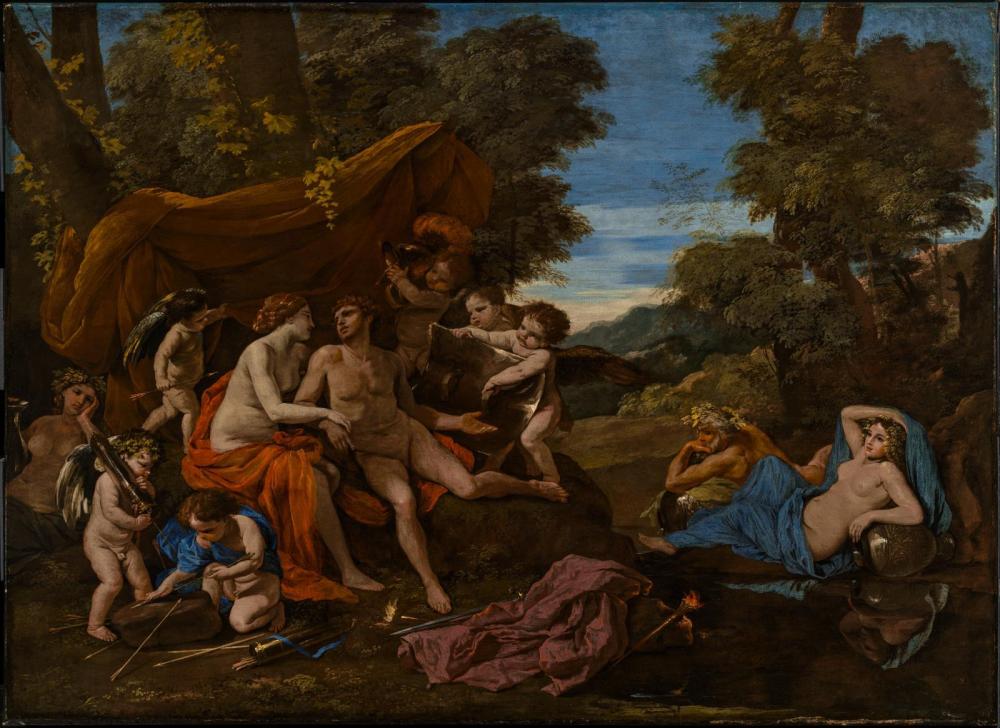Advanced Search 

Mars and Venus
Nicolas Poussin (French (active in Rome), 1594–1665)
about 1630
Medium/Technique
Oil on canvas
Dimensions
154.9 x 213.7 cm (61 x 84 1/8 in.)
Credit Line
Augustus Hemenway Fund and Arthur William Wheelwright Fund
Accession Number40.89
CollectionsEurope
ClassificationsPaintings
Poussin was the foremost French painter of the seventeenth century, although he spent almost his entire career in Rome. His restrained and idealizing style, inspired by the art of classical antiquity and the Renaissance, influenced the course of French painting for three hundred years. This allegory of the triumph of love over war shows Mars, god of war, enraptured by Venus, goddess of love, while her attendant Cupids make playthings of his weapons and armor. In its harmonious landscape, warm tonalities, and sensuous mood, this early work demonstrates Poussin's deep admiration of painters of the Venetian Renaissance.
Provenance1689, Carlo Antonio dal Pozzo (b. 1606 - d. 1689), Rome [see note 1]; by descent to his son, Gabriele dal Pozzo (d. 1695), Rome [see note 2]; by descent to his widow, Anna Teresa Benzoni, Marchesa Lancellotti de'Ginnetti, Rome [see note 3]; 1730, sold in Florence, either to Henry Furnese (d. 1756), Gunnersbury Park, England or to his cousin, Robert Furnese (b. before 1697 - d. 1733), 2d Bt., from whom it passed to Henry Furnese (d. 1756), Gunnersbury Park; February 4, 1758, posthumous Henry Furnese sale, Prestage, London, lot 55, to Simon Harcourt, 1st Earl Harcourt (b. 1714 - d. 1777), Nuneham, England [see note 4]; until 1940, by descent within the family; 1940, sold by Lord Harcourt, through Roland and Delbanco, London, to the MFA for $25,000. (Accession Date: April 11, 1940)
NOTES:
[1] This has been identified with the Mars and Venus in Carlo Antonio dal Pozzo's posthumous inventory of 1689. See Francis Haskell and Sheila Rinehart, "The Dal Pozzo Collection, Some New Evidence, Part I" Burlington Magazine 102 (July, 1960): 318-326, esp. Appendix 2, p. 324. How he acquired it is not known. Both he and his brother, Cassiano del Pozzo, were friends and patrons of Poussin, and both possessed art collections. Cassiano left his art collection to his brother upon his death in 1657, but its contents were not recorded, so it is not known if the Mars and Venus had been included. For further on Carlo Antonio, see Donatella L. Sparti, "Carlo Antonio dal Pozzo (1606-1689): An Unknown Collector," Journal of the History of Collections 2, no. 1 (1990): 7-20.
[2] The painting appears in an inventory of his collection, made shortly after his death in 1695 (no. 100, "Altro quadro di 7, e 9 con La favola di monsù Pusino"); see Arnauld Brejon de Lavergnée, "Tableaux de Poussin et d'autres artistes français dans la collection Dal Pozzo: deux inventaires inédits," Revue de l'Art 19 (1973): 79-96 and Timothy J. Standring, "Some Pictures in the Dal Pozzo Collection: Three New Inventories," Burlington Magazine 130 (August, 1988): 611-613.
[3] In 1729 an inventory of the collection was drawn up, when the Marchesa retained custody of the picture collection for her son and Gabriele's heir, Cosimo Antonio Dal Pozzo (d. 1740); Mars and Venus appears as "Bacchanale," see Standring (as above, n. 2). A legal declaration of 1731 records that in 1730 four pictures by Poussin, held by the Marchesa, were sold to Englishmen in Florence. As Standring has shown, the Mars and Venus was among them, and the purchaser was probably either Robert Furnese or his cousin, the collector Henry Furnese.
[4] The name of the purchaser is recorded in a copy of the auction catalogue. Also see Edward William Harcourt, ed., "The Harcourt Papers" (Oxford, 1880-1905), vol. 3, p. 233.
NOTES:
[1] This has been identified with the Mars and Venus in Carlo Antonio dal Pozzo's posthumous inventory of 1689. See Francis Haskell and Sheila Rinehart, "The Dal Pozzo Collection, Some New Evidence, Part I" Burlington Magazine 102 (July, 1960): 318-326, esp. Appendix 2, p. 324. How he acquired it is not known. Both he and his brother, Cassiano del Pozzo, were friends and patrons of Poussin, and both possessed art collections. Cassiano left his art collection to his brother upon his death in 1657, but its contents were not recorded, so it is not known if the Mars and Venus had been included. For further on Carlo Antonio, see Donatella L. Sparti, "Carlo Antonio dal Pozzo (1606-1689): An Unknown Collector," Journal of the History of Collections 2, no. 1 (1990): 7-20.
[2] The painting appears in an inventory of his collection, made shortly after his death in 1695 (no. 100, "Altro quadro di 7, e 9 con La favola di monsù Pusino"); see Arnauld Brejon de Lavergnée, "Tableaux de Poussin et d'autres artistes français dans la collection Dal Pozzo: deux inventaires inédits," Revue de l'Art 19 (1973): 79-96 and Timothy J. Standring, "Some Pictures in the Dal Pozzo Collection: Three New Inventories," Burlington Magazine 130 (August, 1988): 611-613.
[3] In 1729 an inventory of the collection was drawn up, when the Marchesa retained custody of the picture collection for her son and Gabriele's heir, Cosimo Antonio Dal Pozzo (d. 1740); Mars and Venus appears as "Bacchanale," see Standring (as above, n. 2). A legal declaration of 1731 records that in 1730 four pictures by Poussin, held by the Marchesa, were sold to Englishmen in Florence. As Standring has shown, the Mars and Venus was among them, and the purchaser was probably either Robert Furnese or his cousin, the collector Henry Furnese.
[4] The name of the purchaser is recorded in a copy of the auction catalogue. Also see Edward William Harcourt, ed., "The Harcourt Papers" (Oxford, 1880-1905), vol. 3, p. 233.
